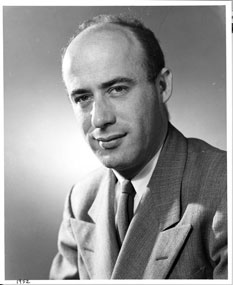John Gofman
Year: March 3rd, 2004
Interviewed by: Blackburn, Henry
Abstract
Dr. Gofman reviews his varied career, from nuclear physics to CVD epidemiology. From his early work in nuclear physics as a student of Glenn Seaborg, his work has crossed disciplinary boundaries. His interests in nuclear physics and medicine took him to the Manhattan Project as well as the Committee for Nuclear Responsibility and the Atomic Energy Commission’s Hiroshima Study and through continuing questions about the threshold of therapeutic doses of radiation. His interest in centrifuges helped him gain access to lipoprotein fractionation and then clinical and epidemiological research in atherosclerosis.
Gofman discusses his methodological concerns regarding statistical methods and prediction with lipoprotein. He shares stories about such important personages as Adlai Stevenson, Mary Lasker, Felix Moore, Paul Dudley White, and Robert Oppenheimer, as well as an anecdote about his centrifuge work with George Mann. His work on the Cooperative Study is also considered, and the questions around HDL/LDL cholesterol. (Suzanne Fisher)
Quotes
JG: I would say that Paul White was… He was somebody out there on a cloud. Very capable. He wrote the then leading textbook on the heart. He was very friendly all the time. He just seemed to be friendly with everyone. Nobody could find anything wrong with Paul Dudley White except for one little thing. [this is the story} Mary called me up and said, “We have to go into Congress. They are discussing the appropriation …”
HB: For NIH?
JG: “NIH and we need more money and it’s got to be a powerful presentation.” That was the one where Sam…
HB: Rayburn?
JG: Rayburn took us to lunch. And Mary was…
HB: And you, and?
JG: And Irv Wright.
HB: What a crew. All you needed was Lyndon, himself.
JG: We were all just talking and Paul White was to head the whole thing. As I said, Paul White is out there on a cloud. Very sharp, but you ask him a question and he’d say, “Oh, yeah, I can tell you about this.” And he did. At any rate, the hearings got started and Irv Wright talked and I talked and someone else talked, and then Paul White was going to wrap it all up. Paul White was on his cloud and he just couldn’t get the message as to what question they were asking in the Congress.
HB: So he wasn’t responding appropriately.
JG: He wasn’t responding and Irv Wright looked at me and Mary…
HB: Oh God, the whole thing was going down the drain.
JG: You don’t take a man like Paul White and tell him what the question is. You just cannot do this. So Irv Wright would try a little thing…
HB: A suggestion to try to get him on track.
JG: It went on for quite a while and finally at one point Paul White just lit up, he finally understood the question and he gave about a 10-minute classic oration of it and that’s how we got through that hearing.
Seaborg was a very, very brilliant guy, but he had one failing. That failing was we were working our butts off like Arthur Wall was the first Seaborg graduate student and Garrett Freelander was the second and I was the third. Seaborg took off his lab coat when the three graduate students appeared and never put a lab coat on again. Because he had these guys who were just workers and we were working our butts off and Seaborg would show up at 11:00 at night, 11:30 at night and we acted as though we didn’t know he was there. And he’d first stand on one foot and then on the other and say, “Is there anything new today?”
Full Transcript Access
Full transcripts of interviews may be made available to those engaged with original materials for scholarly studies by contacting us.
